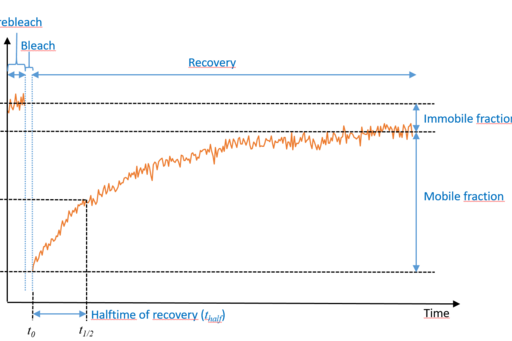
Photobleaching and photoactivation
Fluorescence Recovery After Photobleaching (FRAP), inverse FRAP, Fluorescence Loss In Photobleaching (FLIP ) and photoactivation (PA) enables the study of molecular dynamics in living cells by bleaching a region-of-interest and monitoring the fluorescence, either in the same region or in different parts of the sample, with a time series of images.
FRAP is used to measure the dynamics of 2D or 3D molecular mobility, e.g. diffusion, transport or any other kind of movement of fluorescently labeled molecules in membranes or in living cells.
In this technique, the recovery of fluorescence in a defined region of interest (ROI) of a sample after a bleaching event is monitored by taking a time series of images. The recovery of fluorescence results from the movement of unbleached fluorophores from the surroundings into the bleached area.

The mean intensity in the ROI is plotted versus time, where the recovery time (half-time) indicates the speed of this mobility, e.g. diffusion time, and the level of fully recovered intensity gives information on mobile/immobile species of the fluorescent molecule.

A related method is Fluorescence Loss in Photobleaching (FLIP), which is the decrease/disappearance of fluorescence in a defined region adjacent to a repetitively bleached region. Similar to FRAP, FLIP is used to measure the dynamics of molecular mobility in membranes or in living cells, but especially the ability of a molecule to move between different organelles in the cell, for example between the nucleus and the cytoplasm.

In Inverse FRAP (iFRAP) you bleach everything except for a smaller region-of-interest. During the time lapse, which is collected after the bleaching event, the non-bleached molecules or structures an be followed as they spread in the cell.

Photoactivation is very similar to iFRAP measurements, but instad of bleaching most of the fluorophores a small set of fluorophores are activated, which means that they go from a dark state to a bright state or from one color to another. For this technique specific photoactivatable or photoconvertable fluorophores must be used.
The advantage of this technique is that a much lower laser power can be used for the photoactivation than what is needed for photobleaching, which means that it is gentler to live cells.
